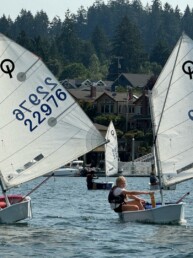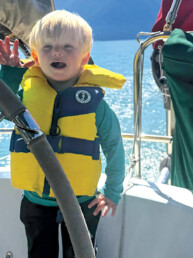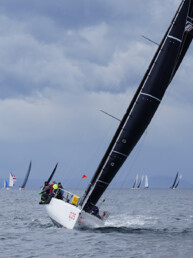IRC Doublehanded European Championship
Alyosha kicks it off:
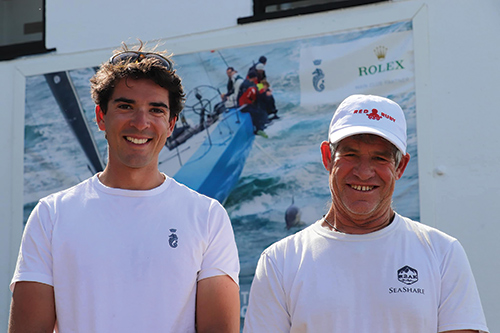
This was going to be the toughest regatta yet for Jonathan and I on our shared Jeanneau Sun Fast 3300, Red Ruby. We would be competing against 56 other talented, well-prepared boats in a two-race series, and the first course was simple: start in La Trinite and finish in front of the Royal Ocean Racing Club (RORC) on the Isle of Wight some 40-55 hours later. However, negotiating up and around the Breton coastline means sailing past some of the most infamous places in the Atlantic. Photographs of “Raz de Sein” and “Chenal du Four” give you the idea of how tricky — and potentially dangerous — this part of the world can be! We were excited but also a little nervous.
For our race, the weather looked relatively benign. The forecast was for a moderate beat up to 15 knots around Brest, followed by a quick spinnaker run across the English Channel, with the only major decision there being which side of a TSS exclusion zone to go around.
We had a good start and managed to be one of the first seven or so boats past the La Teignouse Lighthouse, which guards the entrance of the Bay of Quiberon. Out on the ocean, the wind had subsided to about 10 knots so we immediately peeled to the J1 and continued our way out to the northeast on port tack towards the Isle de Groix and Lorient. Here, the wind began to lighten considerably and we ended up taking a tack back out towards the west and separating from our main group towards the right. Although we ended up consolidating a pretty big loss on the boats who were farther to the left, we gained on the rest of the fleet and, as we sailed past the western side of Groix, we were among the top eight boats in our fleet.
As the night wore on, the breeze began to destabilize and a few drops of rain showed that the forecasted weak front was about to be upon us. The next 6 hours essentially decided the race as the fleet sailed up towards the peninsula of Penmarche. As the wind totally died, you had to make a choice. Position yourself farther to the right to benefit from less adverse tide and potentially some early morning drainage breeze off the land, or, you could make a move to the west, beyond the peninsula and hope to get back into the remnants of the gradient northwesterly. On Red Ruby, we had the unfortunate experience of picking neither and staying in the middle. This turned out to be incredibly costly as we quickly sailed out of the top 10 and back into the 40s. Once the breeze filled back in around noon and we made it around Penmarche, we were over 10 miles behind our class leaders.
Our focus was now very simple. We were in a bad spot, however, our position would become exponentially worse if we didn’t manage to make the tide gates at the Raz De Sein and Chenal du Four. We doubled down and worked as hard as we could for the next several hours and managed to squeak around the Chenal du Four as the tide barely started to turn. Finally, we managed to get freed up enough to set our spinnaker, and we set the A2 in a 10-14 knot westerly and began to sail fast towards the UK coast — expecting a left shift.
What followed was 12-14 hours of extremely steady running conditions in about 12 knots of wind. We eventually found a decent mode, although boats with big symmetrical kites were proving to be tough to keep up with in the dead running conditions (we have A sails and no pole). We did our best to stay in the game and wait for another opportunity. And boy did an opportunity come.
On the afternoon of the third day, a distinctive cloud line began to be visible to the north. Looking at the AIS tracker data, we quickly realized this was going to bring a pretty extreme right shift, so we worked hard to position ourselves farther to the south than the rest of the fleet. This paid off well as we managed to pull back 4-5 miles on the boats around us and keep Red Ruby moving fast in the variable and shifty cloud-induced wind. The clouds following the front seemed to stall out over the fleet for a while and we spent the next 4 hours running in less than 8 knots and in extreme rain. It was wet! Fortunately, we were able to keep the boat moving well and continued to gain on the boats around us. By this point we were nearly in the top 20, which felt amazing considering how far behind we were 36 hours earlier.
The weather gods were not done yet! As we approached the Needles, we knew the wind was expected to shift to the right even more, so we continued to protect the south side of the course. Our positioning again paid dividends as we were now even with the lead SF3300 (a French team). Then, as we were peeling from the 1.5 to the Code Zero, the wind suddenly piped up to 25 knots and we ended up performing a bit of a horror show of a drop, shrimping the kite and running it over.
It took all we could to furl the Code Zero and eventually pull the shredded 1.5 out of the water. Once past the dangers of the Shingles Channel, we realized there were quite a few boats immediately near us, including Diablo, who only owed us about 3 minutes. We quickly re-set the A4 and blasted down the Solent to the finish line, catching Diablo by just a few seconds.
Exhausted and soaking wet, Jonathan and I managed to get the boat put away in some semblance of respectability before staggering off to the RORC where a real bed awaited us.
In the end we were 15th overall, 2nd SF3300, and 2nd non-French boat, in the first of the two-race series. This meant that although we were likely out of contention for the podium, we still had plenty of opportunity to move up after the Cowes-Dinard race.
Jonathan continues the tale:
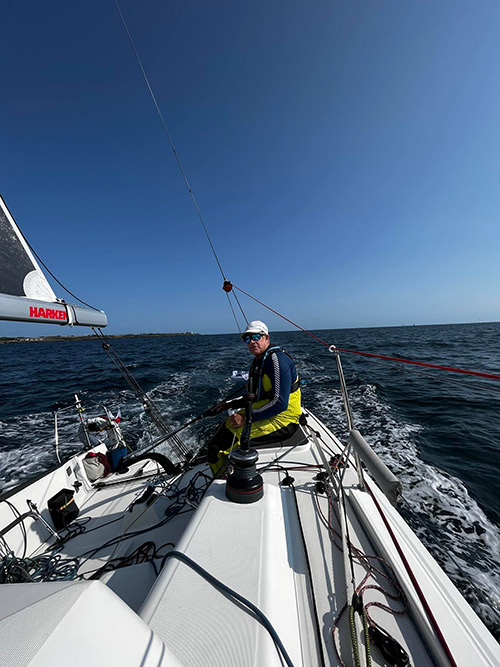 As we heard from Alyosha, the race from France to Cowes was pretty full on, and we appreciated having two full days to recover and prepare for the second race heading back to St. Malo in northern Brittany. These races take a lot out of you, and it is critical to let your mind and body recover from the turmoil you put them through. So we were pretty chill, doing some small boat work projects, socializing with our competitors, starting to look at the weather for the next leg, and trying to rest as much as possible. Cowes is a great sailing town, one of the iconic racing destinations in the world. Half the shops on High Street are sailing related, and there is so much nautical history all around. Think Newport, Rhode Island on a smaller scale… and with British accents.
As we heard from Alyosha, the race from France to Cowes was pretty full on, and we appreciated having two full days to recover and prepare for the second race heading back to St. Malo in northern Brittany. These races take a lot out of you, and it is critical to let your mind and body recover from the turmoil you put them through. So we were pretty chill, doing some small boat work projects, socializing with our competitors, starting to look at the weather for the next leg, and trying to rest as much as possible. Cowes is a great sailing town, one of the iconic racing destinations in the world. Half the shops on High Street are sailing related, and there is so much nautical history all around. Think Newport, Rhode Island on a smaller scale… and with British accents.
As race day arrived, we were feeling calm and prepared. The course consisted of three parts: First, a lightish reach/run out of the Solent and past the Needles. Then a 70-mile reach in medium air across “La Manche” or the English Channel. And finally another 65 miles of tricky upwind through the current infested waters of the Channel Islands and into St. Malo. As an aside, St. Malo has the largest tidal range of any seaport in the world, 12 meters, which translates to 40 feet! Needless to say, this produces some navigational challenges and tons of current. We think we have a lot of current on Puget Sound, but this is next level, or maybe the next level after that.
As soon as we left the dock for the start, we realized something was wrong with our battery charging system. The alternator was not putting any amps into the battery. We picked up a mooring and tried to diagnose the situation, but alas without success. So we went into extreme energy conservation mode, using the instruments only when strictly necessary, and not using the computer for routing or tracking competition, hoping we could milk our charge until the finish. Basically, we monitored the VHF and switched on the instruments occasionally. Although this proved to be a performance issue later in the race, at the time it was strangely liberating.
We got a fairly conservative start with 60 boats on the line and 3 knots of current trying to sweep us over. We worked hard in the puffy wind near the Isle of Wight and were among the leaders exiting the west end of the Solent. There was a period of light air, then the predicted easterly gradient filled in to take us across the Channel. With the Code Zero and staysail, we made good time reaching in 15 knots of wind. As the sun went down, the current changed, which made the angle broader and we peeled to the spinnaker. As we approached the south side of the Channel at Casquets, the current started to really rip, nearly 5 knots against us. The breeze also started getting unstable. We went back to the Code Zero for a while, then got headed and put up the jib.
Now it was getting really tricky… also really dark. There were millions of lights around from the 215 other competitors. The current was smoking against us but was starting to change. The wind went way right, and we tacked onto starboard. In retrospect, we should have tacked sooner, as there was more favorable current to the east, which we didn’t really internalize as well as we could have. We started seeing boats that were well behind us, so we knew we had made a loss, but it was still dark and the beat up the north side of Guernsey to the Les Hanois light was demanding our full attention. Eventually, we got back on our feet and as the sun rose there were still boats everywhere, and all to play for. We expected the wind to go right, so we positioned ourselves to the west of most of the fleet. But during that morning the breeze died and went left, so we were not in a great spot with 25 miles to go.

Alas, we kept fighting, since there was really no other option. As the wind completely died, we started playing for a sea breeze. An hour later we were rewarded not by a thermal, but by a huge storm cloud that developed just west of us. Soon we were flying downwind in 20 knots, heading right for the finish. After a few jibes the wind stabilized and we had a nice run into St. Malo. The cloud had saved us from complete humiliation, but we are still scratching our heads about how to do better next time we encounter those conditions.
In the end we got 8th in IRC Double of 64 starters, and 25th overall IRC of 179. Combined with the La Trinite to Cowes result, this gave us 9th overall for the IRC Doublehanded Europeans. One British boat beat us, and the rest were French (mostly JPK 1010s). Many of the French teams have been training together this winter and spring, and it really showed. They have consistently good speed, they keep the weed off their foils, and they are really good at playing the current as it interacts with islands and headlands. So, we have some work to get to that level. But now we know where the bar is.
We’re back home now, but it’s hard to shake the memories of our incredible trip to France and England. We sailed well, tried as hard as we know how, and made progress in a number of areas. But we have yet to put together a complete longer race that shows our potential. So we will be back with that as our goal for our next event in September in Spain.


